Consumer Market and Buyer Behavior Assignment 2022
VerifiedAdded on 2022/06/07
|15
|4385
|16
Assignment
AI Summary
Contribute Materials
Your contribution can guide someone’s learning journey. Share your
documents today.
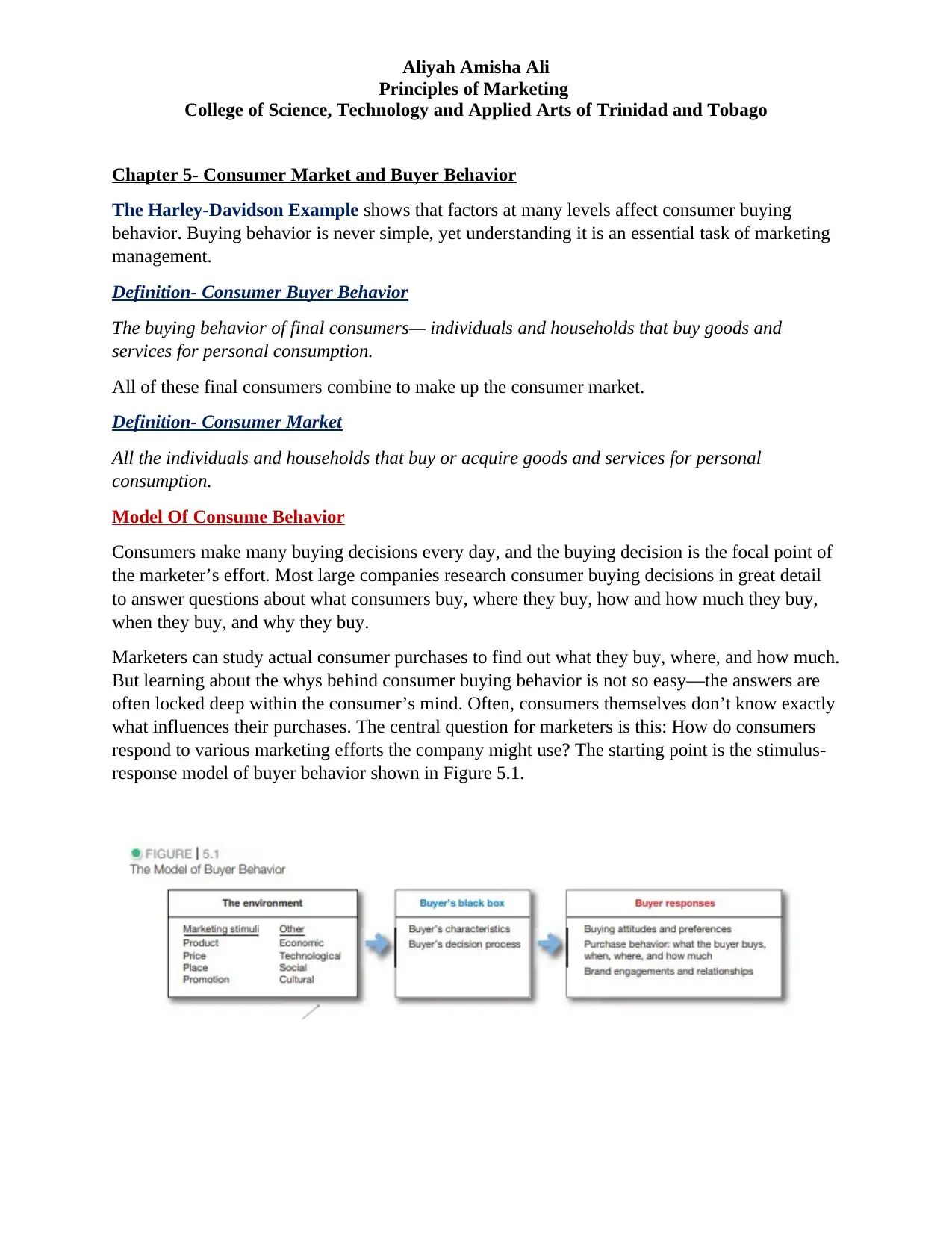
Aliyah Amisha Ali
Principles of Marketing
College of Science, Technology and Applied Arts of Trinidad and Tobago
Chapter 5- Consumer Market and Buyer Behavior
The Harley-Davidson Example shows that factors at many levels affect consumer buying
behavior. Buying behavior is never simple, yet understanding it is an essential task of marketing
management.
Definition- Consumer Buyer Behavior
The buying behavior of final consumers— individuals and households that buy goods and
services for personal consumption.
All of these final consumers combine to make up the consumer market.
Definition- Consumer Market
All the individuals and households that buy or acquire goods and services for personal
consumption.
Model Of Consume Behavior
Consumers make many buying decisions every day, and the buying decision is the focal point of
the marketer’s effort. Most large companies research consumer buying decisions in great detail
to answer questions about what consumers buy, where they buy, how and how much they buy,
when they buy, and why they buy.
Marketers can study actual consumer purchases to find out what they buy, where, and how much.
But learning about the whys behind consumer buying behavior is not so easy—the answers are
often locked deep within the consumer’s mind. Often, consumers themselves don’t know exactly
what influences their purchases. The central question for marketers is this: How do consumers
respond to various marketing efforts the company might use? The starting point is the stimulus-
response model of buyer behavior shown in Figure 5.1.
Principles of Marketing
College of Science, Technology and Applied Arts of Trinidad and Tobago
Chapter 5- Consumer Market and Buyer Behavior
The Harley-Davidson Example shows that factors at many levels affect consumer buying
behavior. Buying behavior is never simple, yet understanding it is an essential task of marketing
management.
Definition- Consumer Buyer Behavior
The buying behavior of final consumers— individuals and households that buy goods and
services for personal consumption.
All of these final consumers combine to make up the consumer market.
Definition- Consumer Market
All the individuals and households that buy or acquire goods and services for personal
consumption.
Model Of Consume Behavior
Consumers make many buying decisions every day, and the buying decision is the focal point of
the marketer’s effort. Most large companies research consumer buying decisions in great detail
to answer questions about what consumers buy, where they buy, how and how much they buy,
when they buy, and why they buy.
Marketers can study actual consumer purchases to find out what they buy, where, and how much.
But learning about the whys behind consumer buying behavior is not so easy—the answers are
often locked deep within the consumer’s mind. Often, consumers themselves don’t know exactly
what influences their purchases. The central question for marketers is this: How do consumers
respond to various marketing efforts the company might use? The starting point is the stimulus-
response model of buyer behavior shown in Figure 5.1.
Secure Best Marks with AI Grader
Need help grading? Try our AI Grader for instant feedback on your assignments.
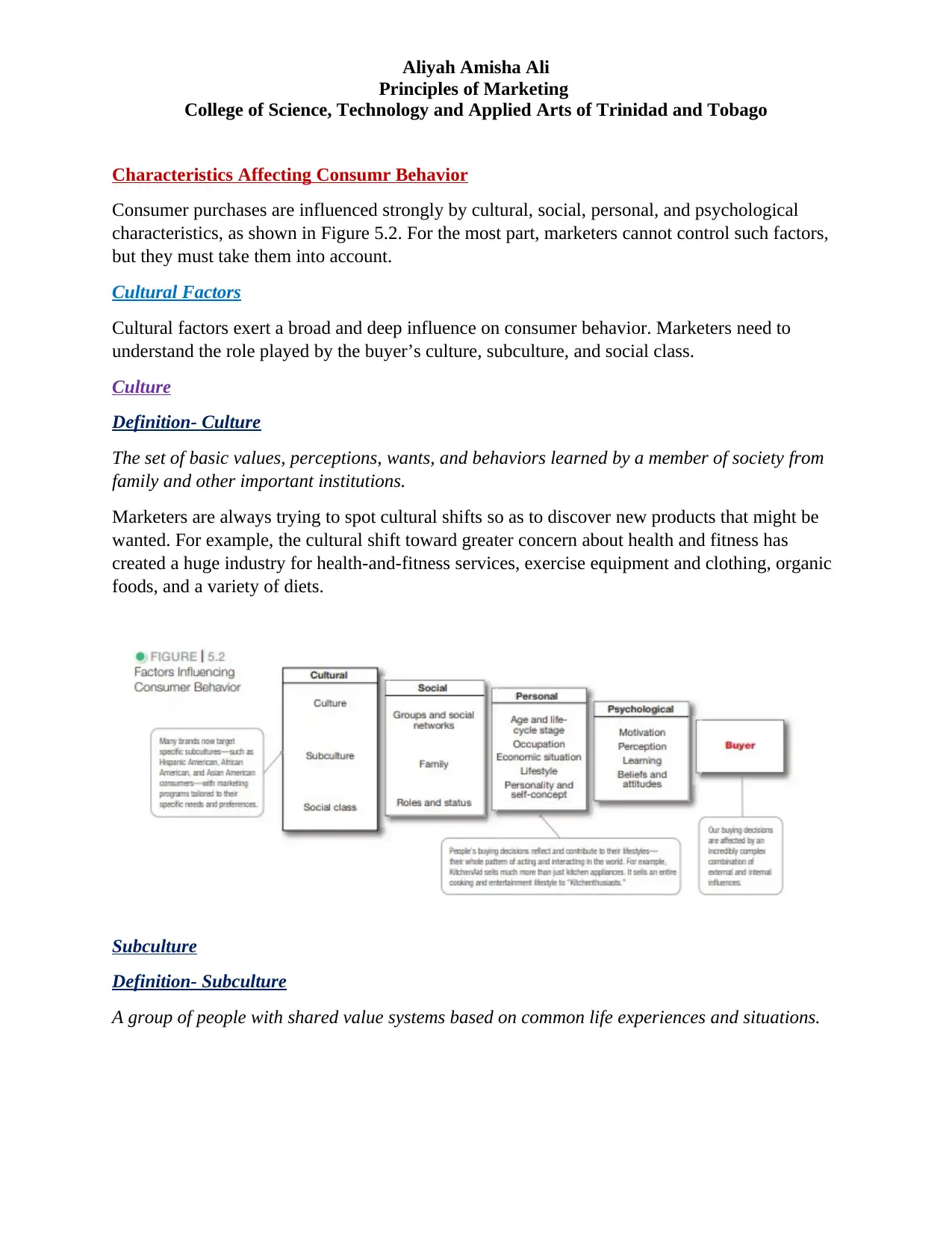
Aliyah Amisha Ali
Principles of Marketing
College of Science, Technology and Applied Arts of Trinidad and Tobago
Characteristics Affecting Consumr Behavior
Consumer purchases are influenced strongly by cultural, social, personal, and psychological
characteristics, as shown in Figure 5.2. For the most part, marketers cannot control such factors,
but they must take them into account.
Cultural Factors
Cultural factors exert a broad and deep influence on consumer behavior. Marketers need to
understand the role played by the buyer’s culture, subculture, and social class.
Culture
Definition- Culture
The set of basic values, perceptions, wants, and behaviors learned by a member of society from
family and other important institutions.
Marketers are always trying to spot cultural shifts so as to discover new products that might be
wanted. For example, the cultural shift toward greater concern about health and fitness has
created a huge industry for health-and-fitness services, exercise equipment and clothing, organic
foods, and a variety of diets.
Subculture
Definition- Subculture
A group of people with shared value systems based on common life experiences and situations.
Principles of Marketing
College of Science, Technology and Applied Arts of Trinidad and Tobago
Characteristics Affecting Consumr Behavior
Consumer purchases are influenced strongly by cultural, social, personal, and psychological
characteristics, as shown in Figure 5.2. For the most part, marketers cannot control such factors,
but they must take them into account.
Cultural Factors
Cultural factors exert a broad and deep influence on consumer behavior. Marketers need to
understand the role played by the buyer’s culture, subculture, and social class.
Culture
Definition- Culture
The set of basic values, perceptions, wants, and behaviors learned by a member of society from
family and other important institutions.
Marketers are always trying to spot cultural shifts so as to discover new products that might be
wanted. For example, the cultural shift toward greater concern about health and fitness has
created a huge industry for health-and-fitness services, exercise equipment and clothing, organic
foods, and a variety of diets.
Subculture
Definition- Subculture
A group of people with shared value systems based on common life experiences and situations.
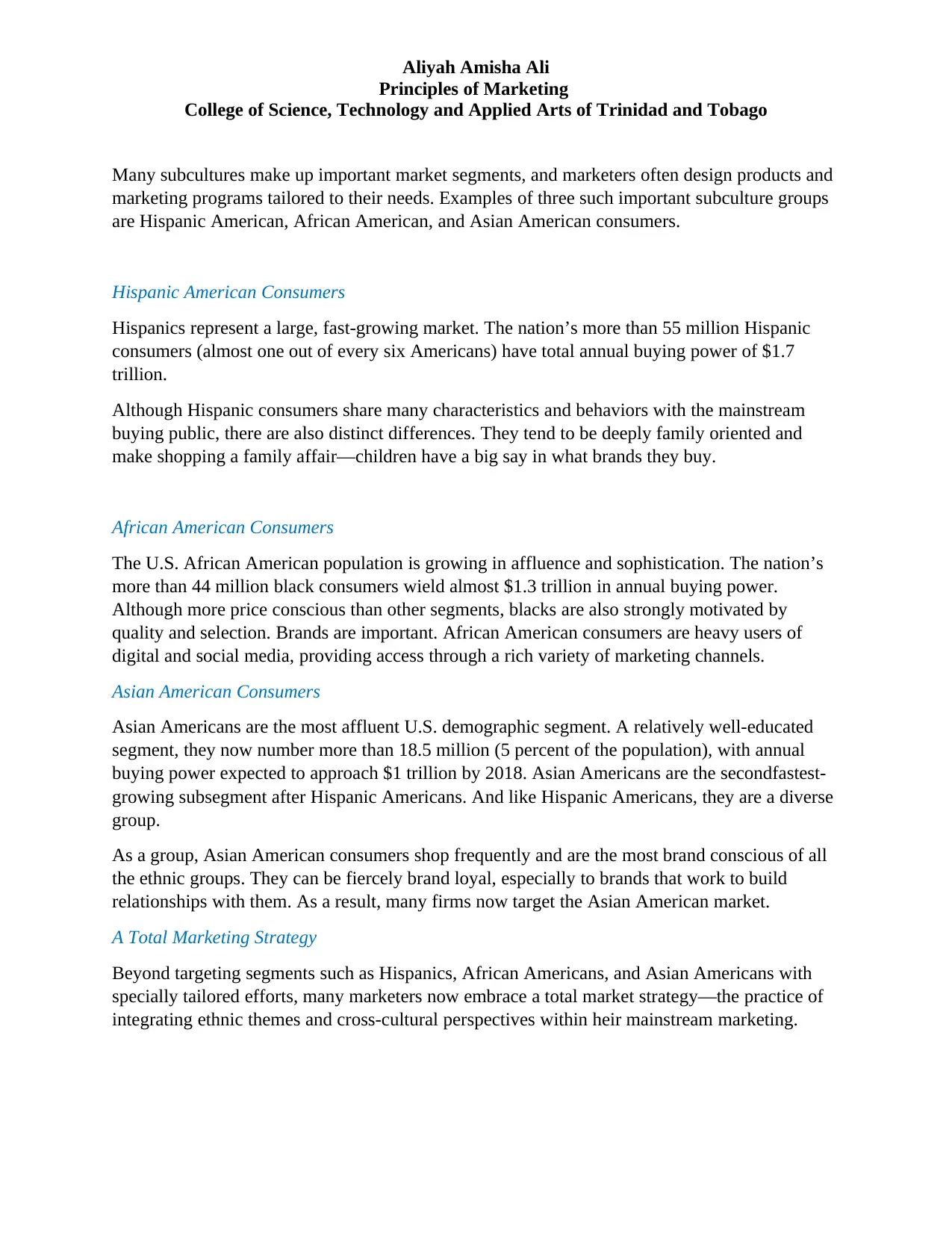
Aliyah Amisha Ali
Principles of Marketing
College of Science, Technology and Applied Arts of Trinidad and Tobago
Many subcultures make up important market segments, and marketers often design products and
marketing programs tailored to their needs. Examples of three such important subculture groups
are Hispanic American, African American, and Asian American consumers.
Hispanic American Consumers
Hispanics represent a large, fast-growing market. The nation’s more than 55 million Hispanic
consumers (almost one out of every six Americans) have total annual buying power of $1.7
trillion.
Although Hispanic consumers share many characteristics and behaviors with the mainstream
buying public, there are also distinct differences. They tend to be deeply family oriented and
make shopping a family affair—children have a big say in what brands they buy.
African American Consumers
The U.S. African American population is growing in affluence and sophistication. The nation’s
more than 44 million black consumers wield almost $1.3 trillion in annual buying power.
Although more price conscious than other segments, blacks are also strongly motivated by
quality and selection. Brands are important. African American consumers are heavy users of
digital and social media, providing access through a rich variety of marketing channels.
Asian American Consumers
Asian Americans are the most affluent U.S. demographic segment. A relatively well-educated
segment, they now number more than 18.5 million (5 percent of the population), with annual
buying power expected to approach $1 trillion by 2018. Asian Americans are the secondfastest-
growing subsegment after Hispanic Americans. And like Hispanic Americans, they are a diverse
group.
As a group, Asian American consumers shop frequently and are the most brand conscious of all
the ethnic groups. They can be fiercely brand loyal, especially to brands that work to build
relationships with them. As a result, many firms now target the Asian American market.
A Total Marketing Strategy
Beyond targeting segments such as Hispanics, African Americans, and Asian Americans with
specially tailored efforts, many marketers now embrace a total market strategy—the practice of
integrating ethnic themes and cross-cultural perspectives within heir mainstream marketing.
Principles of Marketing
College of Science, Technology and Applied Arts of Trinidad and Tobago
Many subcultures make up important market segments, and marketers often design products and
marketing programs tailored to their needs. Examples of three such important subculture groups
are Hispanic American, African American, and Asian American consumers.
Hispanic American Consumers
Hispanics represent a large, fast-growing market. The nation’s more than 55 million Hispanic
consumers (almost one out of every six Americans) have total annual buying power of $1.7
trillion.
Although Hispanic consumers share many characteristics and behaviors with the mainstream
buying public, there are also distinct differences. They tend to be deeply family oriented and
make shopping a family affair—children have a big say in what brands they buy.
African American Consumers
The U.S. African American population is growing in affluence and sophistication. The nation’s
more than 44 million black consumers wield almost $1.3 trillion in annual buying power.
Although more price conscious than other segments, blacks are also strongly motivated by
quality and selection. Brands are important. African American consumers are heavy users of
digital and social media, providing access through a rich variety of marketing channels.
Asian American Consumers
Asian Americans are the most affluent U.S. demographic segment. A relatively well-educated
segment, they now number more than 18.5 million (5 percent of the population), with annual
buying power expected to approach $1 trillion by 2018. Asian Americans are the secondfastest-
growing subsegment after Hispanic Americans. And like Hispanic Americans, they are a diverse
group.
As a group, Asian American consumers shop frequently and are the most brand conscious of all
the ethnic groups. They can be fiercely brand loyal, especially to brands that work to build
relationships with them. As a result, many firms now target the Asian American market.
A Total Marketing Strategy
Beyond targeting segments such as Hispanics, African Americans, and Asian Americans with
specially tailored efforts, many marketers now embrace a total market strategy—the practice of
integrating ethnic themes and cross-cultural perspectives within heir mainstream marketing.
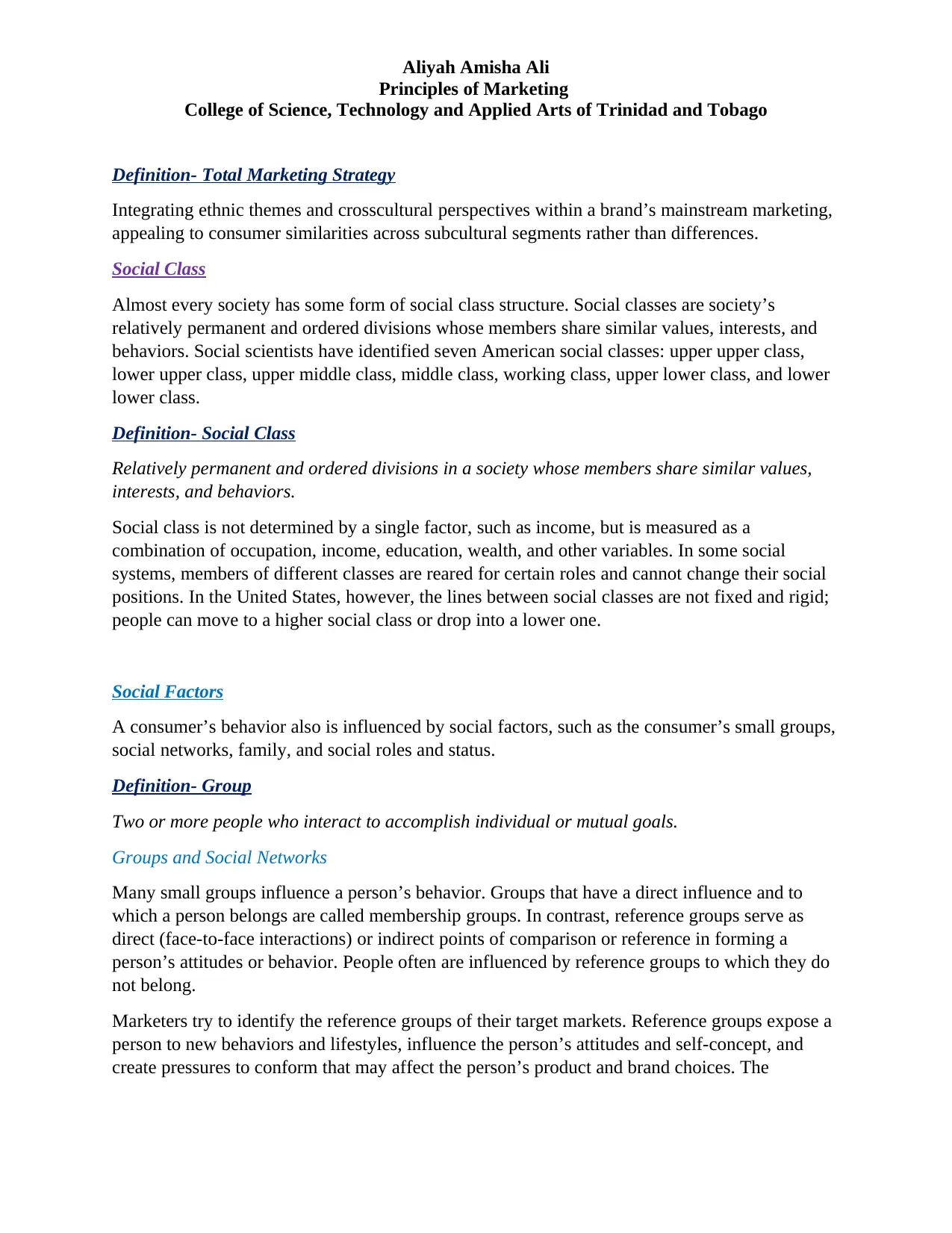
Aliyah Amisha Ali
Principles of Marketing
College of Science, Technology and Applied Arts of Trinidad and Tobago
Definition- Total Marketing Strategy
Integrating ethnic themes and crosscultural perspectives within a brand’s mainstream marketing,
appealing to consumer similarities across subcultural segments rather than differences.
Social Class
Almost every society has some form of social class structure. Social classes are society’s
relatively permanent and ordered divisions whose members share similar values, interests, and
behaviors. Social scientists have identified seven American social classes: upper upper class,
lower upper class, upper middle class, middle class, working class, upper lower class, and lower
lower class.
Definition- Social Class
Relatively permanent and ordered divisions in a society whose members share similar values,
interests, and behaviors.
Social class is not determined by a single factor, such as income, but is measured as a
combination of occupation, income, education, wealth, and other variables. In some social
systems, members of different classes are reared for certain roles and cannot change their social
positions. In the United States, however, the lines between social classes are not fixed and rigid;
people can move to a higher social class or drop into a lower one.
Social Factors
A consumer’s behavior also is influenced by social factors, such as the consumer’s small groups,
social networks, family, and social roles and status.
Definition- Group
Two or more people who interact to accomplish individual or mutual goals.
Groups and Social Networks
Many small groups influence a person’s behavior. Groups that have a direct influence and to
which a person belongs are called membership groups. In contrast, reference groups serve as
direct (face-to-face interactions) or indirect points of comparison or reference in forming a
person’s attitudes or behavior. People often are influenced by reference groups to which they do
not belong.
Marketers try to identify the reference groups of their target markets. Reference groups expose a
person to new behaviors and lifestyles, influence the person’s attitudes and self-concept, and
create pressures to conform that may affect the person’s product and brand choices. The
Principles of Marketing
College of Science, Technology and Applied Arts of Trinidad and Tobago
Definition- Total Marketing Strategy
Integrating ethnic themes and crosscultural perspectives within a brand’s mainstream marketing,
appealing to consumer similarities across subcultural segments rather than differences.
Social Class
Almost every society has some form of social class structure. Social classes are society’s
relatively permanent and ordered divisions whose members share similar values, interests, and
behaviors. Social scientists have identified seven American social classes: upper upper class,
lower upper class, upper middle class, middle class, working class, upper lower class, and lower
lower class.
Definition- Social Class
Relatively permanent and ordered divisions in a society whose members share similar values,
interests, and behaviors.
Social class is not determined by a single factor, such as income, but is measured as a
combination of occupation, income, education, wealth, and other variables. In some social
systems, members of different classes are reared for certain roles and cannot change their social
positions. In the United States, however, the lines between social classes are not fixed and rigid;
people can move to a higher social class or drop into a lower one.
Social Factors
A consumer’s behavior also is influenced by social factors, such as the consumer’s small groups,
social networks, family, and social roles and status.
Definition- Group
Two or more people who interact to accomplish individual or mutual goals.
Groups and Social Networks
Many small groups influence a person’s behavior. Groups that have a direct influence and to
which a person belongs are called membership groups. In contrast, reference groups serve as
direct (face-to-face interactions) or indirect points of comparison or reference in forming a
person’s attitudes or behavior. People often are influenced by reference groups to which they do
not belong.
Marketers try to identify the reference groups of their target markets. Reference groups expose a
person to new behaviors and lifestyles, influence the person’s attitudes and self-concept, and
create pressures to conform that may affect the person’s product and brand choices. The
Secure Best Marks with AI Grader
Need help grading? Try our AI Grader for instant feedback on your assignments.
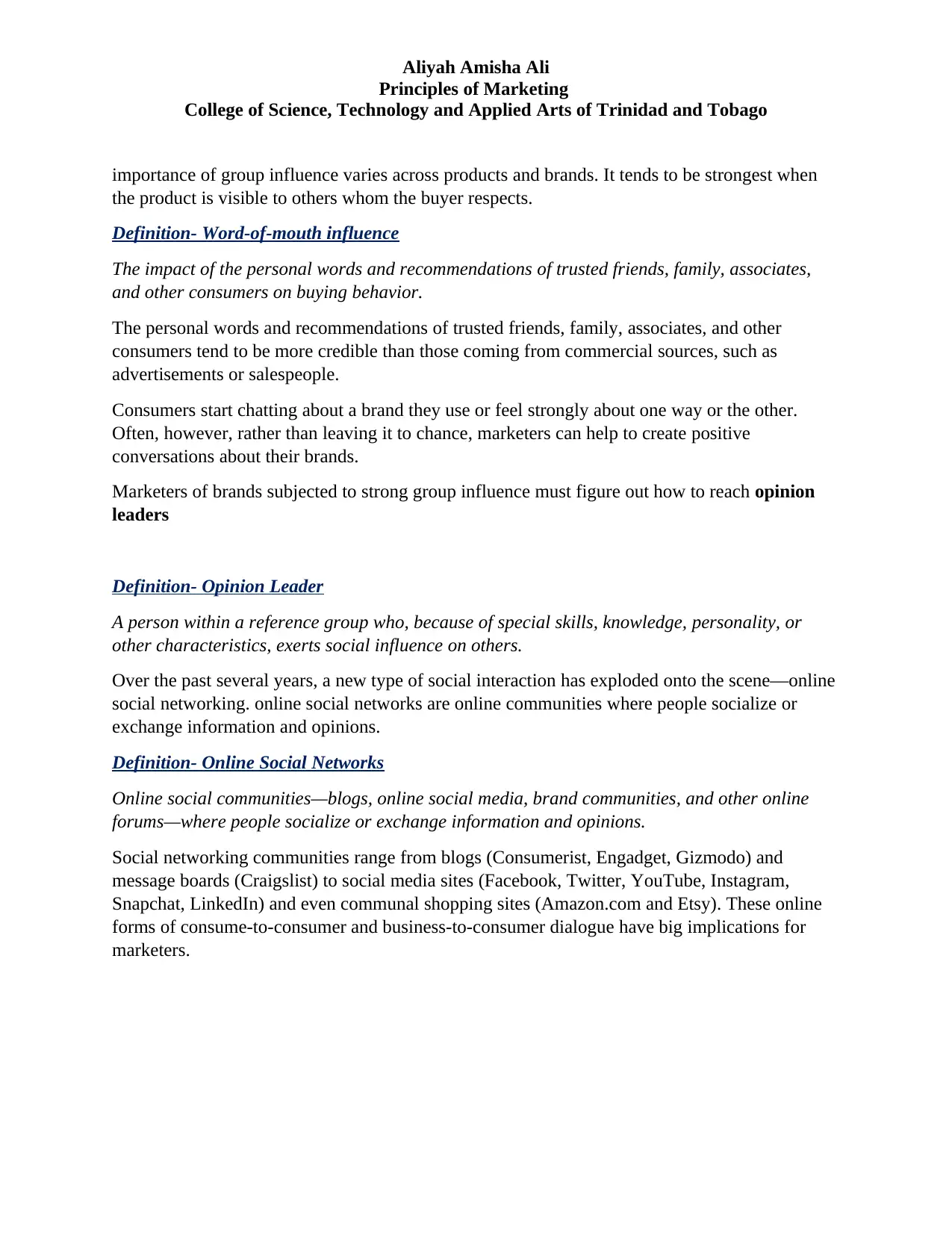
Aliyah Amisha Ali
Principles of Marketing
College of Science, Technology and Applied Arts of Trinidad and Tobago
importance of group influence varies across products and brands. It tends to be strongest when
the product is visible to others whom the buyer respects.
Definition- Word-of-mouth influence
The impact of the personal words and recommendations of trusted friends, family, associates,
and other consumers on buying behavior.
The personal words and recommendations of trusted friends, family, associates, and other
consumers tend to be more credible than those coming from commercial sources, such as
advertisements or salespeople.
Consumers start chatting about a brand they use or feel strongly about one way or the other.
Often, however, rather than leaving it to chance, marketers can help to create positive
conversations about their brands.
Marketers of brands subjected to strong group influence must figure out how to reach opinion
leaders
Definition- Opinion Leader
A person within a reference group who, because of special skills, knowledge, personality, or
other characteristics, exerts social influence on others.
Over the past several years, a new type of social interaction has exploded onto the scene—online
social networking. online social networks are online communities where people socialize or
exchange information and opinions.
Definition- Online Social Networks
Online social communities—blogs, online social media, brand communities, and other online
forums—where people socialize or exchange information and opinions.
Social networking communities range from blogs (Consumerist, Engadget, Gizmodo) and
message boards (Craigslist) to social media sites (Facebook, Twitter, YouTube, Instagram,
Snapchat, LinkedIn) and even communal shopping sites (Amazon.com and Etsy). These online
forms of consume-to-consumer and business-to-consumer dialogue have big implications for
marketers.
Principles of Marketing
College of Science, Technology and Applied Arts of Trinidad and Tobago
importance of group influence varies across products and brands. It tends to be strongest when
the product is visible to others whom the buyer respects.
Definition- Word-of-mouth influence
The impact of the personal words and recommendations of trusted friends, family, associates,
and other consumers on buying behavior.
The personal words and recommendations of trusted friends, family, associates, and other
consumers tend to be more credible than those coming from commercial sources, such as
advertisements or salespeople.
Consumers start chatting about a brand they use or feel strongly about one way or the other.
Often, however, rather than leaving it to chance, marketers can help to create positive
conversations about their brands.
Marketers of brands subjected to strong group influence must figure out how to reach opinion
leaders
Definition- Opinion Leader
A person within a reference group who, because of special skills, knowledge, personality, or
other characteristics, exerts social influence on others.
Over the past several years, a new type of social interaction has exploded onto the scene—online
social networking. online social networks are online communities where people socialize or
exchange information and opinions.
Definition- Online Social Networks
Online social communities—blogs, online social media, brand communities, and other online
forums—where people socialize or exchange information and opinions.
Social networking communities range from blogs (Consumerist, Engadget, Gizmodo) and
message boards (Craigslist) to social media sites (Facebook, Twitter, YouTube, Instagram,
Snapchat, LinkedIn) and even communal shopping sites (Amazon.com and Etsy). These online
forms of consume-to-consumer and business-to-consumer dialogue have big implications for
marketers.
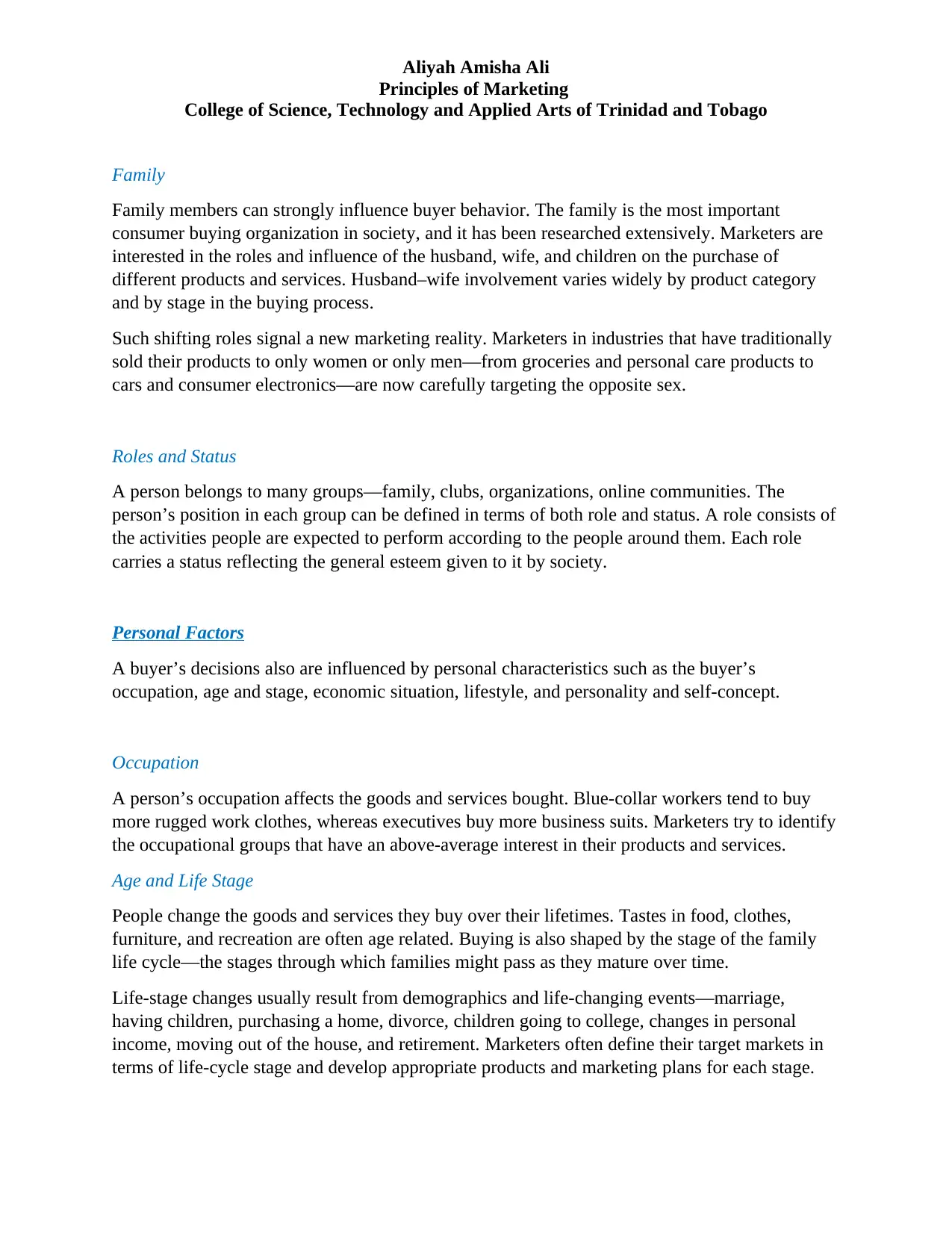
Aliyah Amisha Ali
Principles of Marketing
College of Science, Technology and Applied Arts of Trinidad and Tobago
Family
Family members can strongly influence buyer behavior. The family is the most important
consumer buying organization in society, and it has been researched extensively. Marketers are
interested in the roles and influence of the husband, wife, and children on the purchase of
different products and services. Husband–wife involvement varies widely by product category
and by stage in the buying process.
Such shifting roles signal a new marketing reality. Marketers in industries that have traditionally
sold their products to only women or only men—from groceries and personal care products to
cars and consumer electronics—are now carefully targeting the opposite sex.
Roles and Status
A person belongs to many groups—family, clubs, organizations, online communities. The
person’s position in each group can be defined in terms of both role and status. A role consists of
the activities people are expected to perform according to the people around them. Each role
carries a status reflecting the general esteem given to it by society.
Personal Factors
A buyer’s decisions also are influenced by personal characteristics such as the buyer’s
occupation, age and stage, economic situation, lifestyle, and personality and self-concept.
Occupation
A person’s occupation affects the goods and services bought. Blue-collar workers tend to buy
more rugged work clothes, whereas executives buy more business suits. Marketers try to identify
the occupational groups that have an above-average interest in their products and services.
Age and Life Stage
People change the goods and services they buy over their lifetimes. Tastes in food, clothes,
furniture, and recreation are often age related. Buying is also shaped by the stage of the family
life cycle—the stages through which families might pass as they mature over time.
Life-stage changes usually result from demographics and life-changing events—marriage,
having children, purchasing a home, divorce, children going to college, changes in personal
income, moving out of the house, and retirement. Marketers often define their target markets in
terms of life-cycle stage and develop appropriate products and marketing plans for each stage.
Principles of Marketing
College of Science, Technology and Applied Arts of Trinidad and Tobago
Family
Family members can strongly influence buyer behavior. The family is the most important
consumer buying organization in society, and it has been researched extensively. Marketers are
interested in the roles and influence of the husband, wife, and children on the purchase of
different products and services. Husband–wife involvement varies widely by product category
and by stage in the buying process.
Such shifting roles signal a new marketing reality. Marketers in industries that have traditionally
sold their products to only women or only men—from groceries and personal care products to
cars and consumer electronics—are now carefully targeting the opposite sex.
Roles and Status
A person belongs to many groups—family, clubs, organizations, online communities. The
person’s position in each group can be defined in terms of both role and status. A role consists of
the activities people are expected to perform according to the people around them. Each role
carries a status reflecting the general esteem given to it by society.
Personal Factors
A buyer’s decisions also are influenced by personal characteristics such as the buyer’s
occupation, age and stage, economic situation, lifestyle, and personality and self-concept.
Occupation
A person’s occupation affects the goods and services bought. Blue-collar workers tend to buy
more rugged work clothes, whereas executives buy more business suits. Marketers try to identify
the occupational groups that have an above-average interest in their products and services.
Age and Life Stage
People change the goods and services they buy over their lifetimes. Tastes in food, clothes,
furniture, and recreation are often age related. Buying is also shaped by the stage of the family
life cycle—the stages through which families might pass as they mature over time.
Life-stage changes usually result from demographics and life-changing events—marriage,
having children, purchasing a home, divorce, children going to college, changes in personal
income, moving out of the house, and retirement. Marketers often define their target markets in
terms of life-cycle stage and develop appropriate products and marketing plans for each stage.
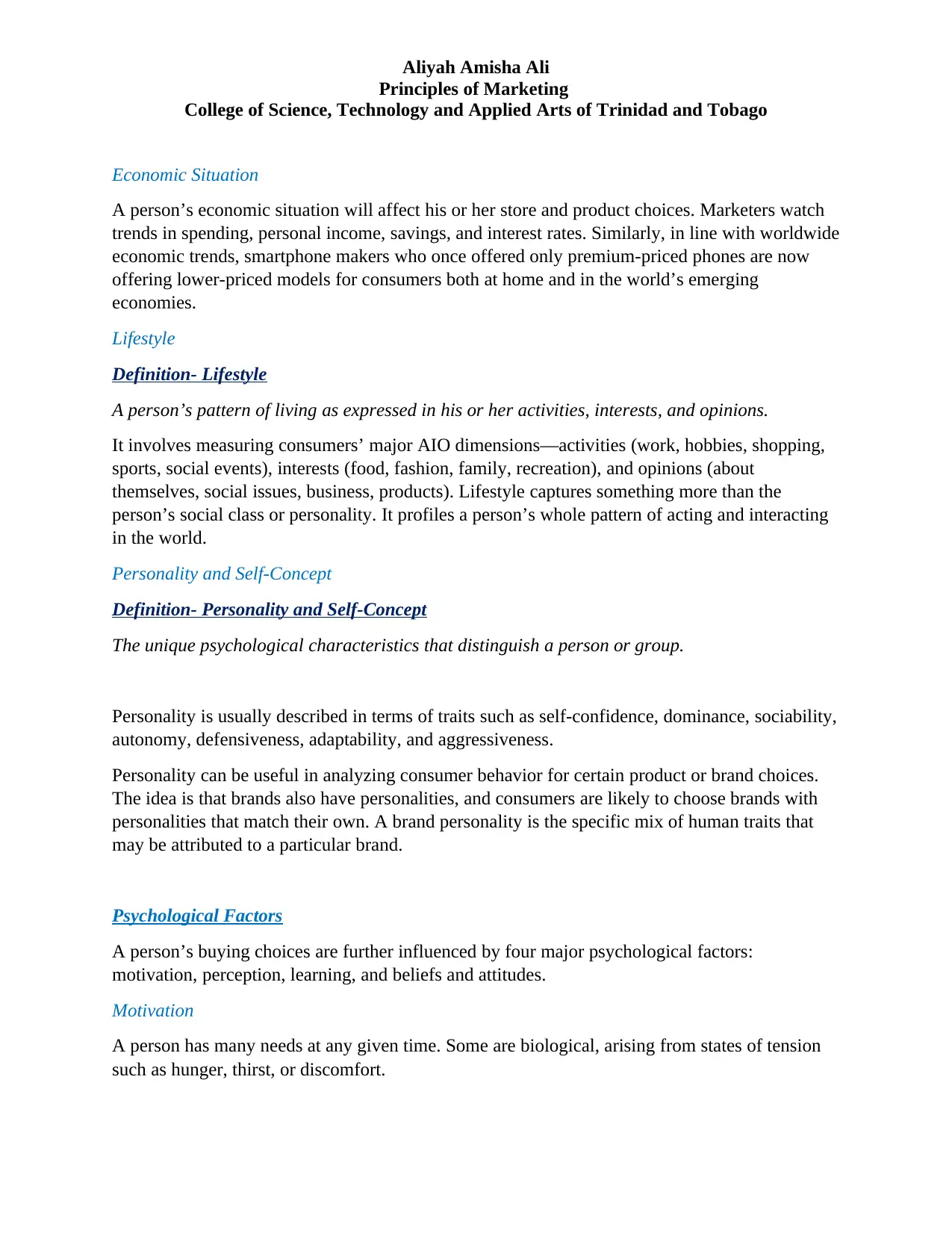
Aliyah Amisha Ali
Principles of Marketing
College of Science, Technology and Applied Arts of Trinidad and Tobago
Economic Situation
A person’s economic situation will affect his or her store and product choices. Marketers watch
trends in spending, personal income, savings, and interest rates. Similarly, in line with worldwide
economic trends, smartphone makers who once offered only premium-priced phones are now
offering lower-priced models for consumers both at home and in the world’s emerging
economies.
Lifestyle
Definition- Lifestyle
A person’s pattern of living as expressed in his or her activities, interests, and opinions.
It involves measuring consumers’ major AIO dimensions—activities (work, hobbies, shopping,
sports, social events), interests (food, fashion, family, recreation), and opinions (about
themselves, social issues, business, products). Lifestyle captures something more than the
person’s social class or personality. It profiles a person’s whole pattern of acting and interacting
in the world.
Personality and Self-Concept
Definition- Personality and Self-Concept
The unique psychological characteristics that distinguish a person or group.
Personality is usually described in terms of traits such as self-confidence, dominance, sociability,
autonomy, defensiveness, adaptability, and aggressiveness.
Personality can be useful in analyzing consumer behavior for certain product or brand choices.
The idea is that brands also have personalities, and consumers are likely to choose brands with
personalities that match their own. A brand personality is the specific mix of human traits that
may be attributed to a particular brand.
Psychological Factors
A person’s buying choices are further influenced by four major psychological factors:
motivation, perception, learning, and beliefs and attitudes.
Motivation
A person has many needs at any given time. Some are biological, arising from states of tension
such as hunger, thirst, or discomfort.
Principles of Marketing
College of Science, Technology and Applied Arts of Trinidad and Tobago
Economic Situation
A person’s economic situation will affect his or her store and product choices. Marketers watch
trends in spending, personal income, savings, and interest rates. Similarly, in line with worldwide
economic trends, smartphone makers who once offered only premium-priced phones are now
offering lower-priced models for consumers both at home and in the world’s emerging
economies.
Lifestyle
Definition- Lifestyle
A person’s pattern of living as expressed in his or her activities, interests, and opinions.
It involves measuring consumers’ major AIO dimensions—activities (work, hobbies, shopping,
sports, social events), interests (food, fashion, family, recreation), and opinions (about
themselves, social issues, business, products). Lifestyle captures something more than the
person’s social class or personality. It profiles a person’s whole pattern of acting and interacting
in the world.
Personality and Self-Concept
Definition- Personality and Self-Concept
The unique psychological characteristics that distinguish a person or group.
Personality is usually described in terms of traits such as self-confidence, dominance, sociability,
autonomy, defensiveness, adaptability, and aggressiveness.
Personality can be useful in analyzing consumer behavior for certain product or brand choices.
The idea is that brands also have personalities, and consumers are likely to choose brands with
personalities that match their own. A brand personality is the specific mix of human traits that
may be attributed to a particular brand.
Psychological Factors
A person’s buying choices are further influenced by four major psychological factors:
motivation, perception, learning, and beliefs and attitudes.
Motivation
A person has many needs at any given time. Some are biological, arising from states of tension
such as hunger, thirst, or discomfort.
Paraphrase This Document
Need a fresh take? Get an instant paraphrase of this document with our AI Paraphraser
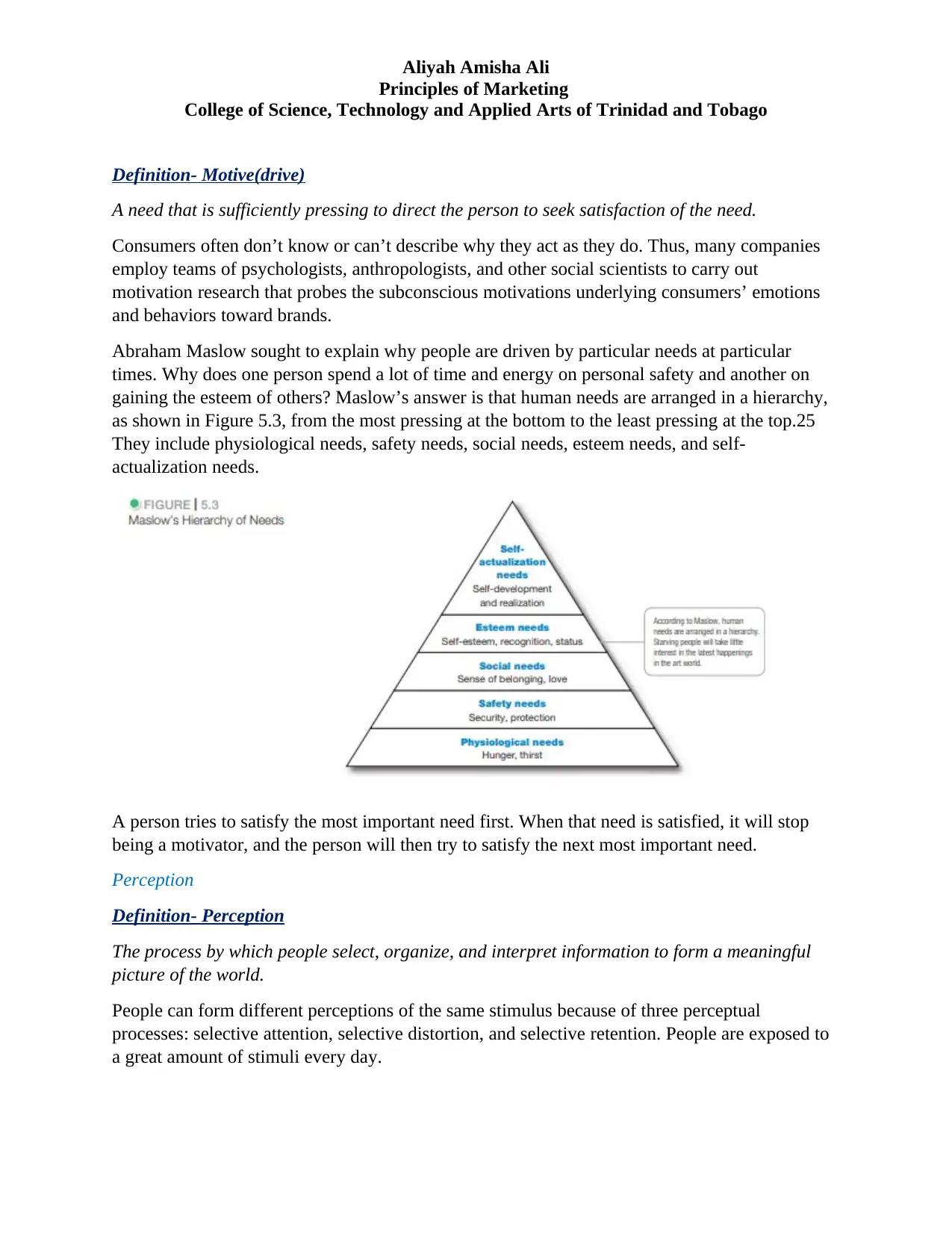
Aliyah Amisha Ali
Principles of Marketing
College of Science, Technology and Applied Arts of Trinidad and Tobago
Definition- Motive(drive)
A need that is sufficiently pressing to direct the person to seek satisfaction of the need.
Consumers often don’t know or can’t describe why they act as they do. Thus, many companies
employ teams of psychologists, anthropologists, and other social scientists to carry out
motivation research that probes the subconscious motivations underlying consumers’ emotions
and behaviors toward brands.
Abraham Maslow sought to explain why people are driven by particular needs at particular
times. Why does one person spend a lot of time and energy on personal safety and another on
gaining the esteem of others? Maslow’s answer is that human needs are arranged in a hierarchy,
as shown in Figure 5.3, from the most pressing at the bottom to the least pressing at the top.25
They include physiological needs, safety needs, social needs, esteem needs, and self-
actualization needs.
A person tries to satisfy the most important need first. When that need is satisfied, it will stop
being a motivator, and the person will then try to satisfy the next most important need.
Perception
Definition- Perception
The process by which people select, organize, and interpret information to form a meaningful
picture of the world.
People can form different perceptions of the same stimulus because of three perceptual
processes: selective attention, selective distortion, and selective retention. People are exposed to
a great amount of stimuli every day.
Principles of Marketing
College of Science, Technology and Applied Arts of Trinidad and Tobago
Definition- Motive(drive)
A need that is sufficiently pressing to direct the person to seek satisfaction of the need.
Consumers often don’t know or can’t describe why they act as they do. Thus, many companies
employ teams of psychologists, anthropologists, and other social scientists to carry out
motivation research that probes the subconscious motivations underlying consumers’ emotions
and behaviors toward brands.
Abraham Maslow sought to explain why people are driven by particular needs at particular
times. Why does one person spend a lot of time and energy on personal safety and another on
gaining the esteem of others? Maslow’s answer is that human needs are arranged in a hierarchy,
as shown in Figure 5.3, from the most pressing at the bottom to the least pressing at the top.25
They include physiological needs, safety needs, social needs, esteem needs, and self-
actualization needs.
A person tries to satisfy the most important need first. When that need is satisfied, it will stop
being a motivator, and the person will then try to satisfy the next most important need.
Perception
Definition- Perception
The process by which people select, organize, and interpret information to form a meaningful
picture of the world.
People can form different perceptions of the same stimulus because of three perceptual
processes: selective attention, selective distortion, and selective retention. People are exposed to
a great amount of stimuli every day.
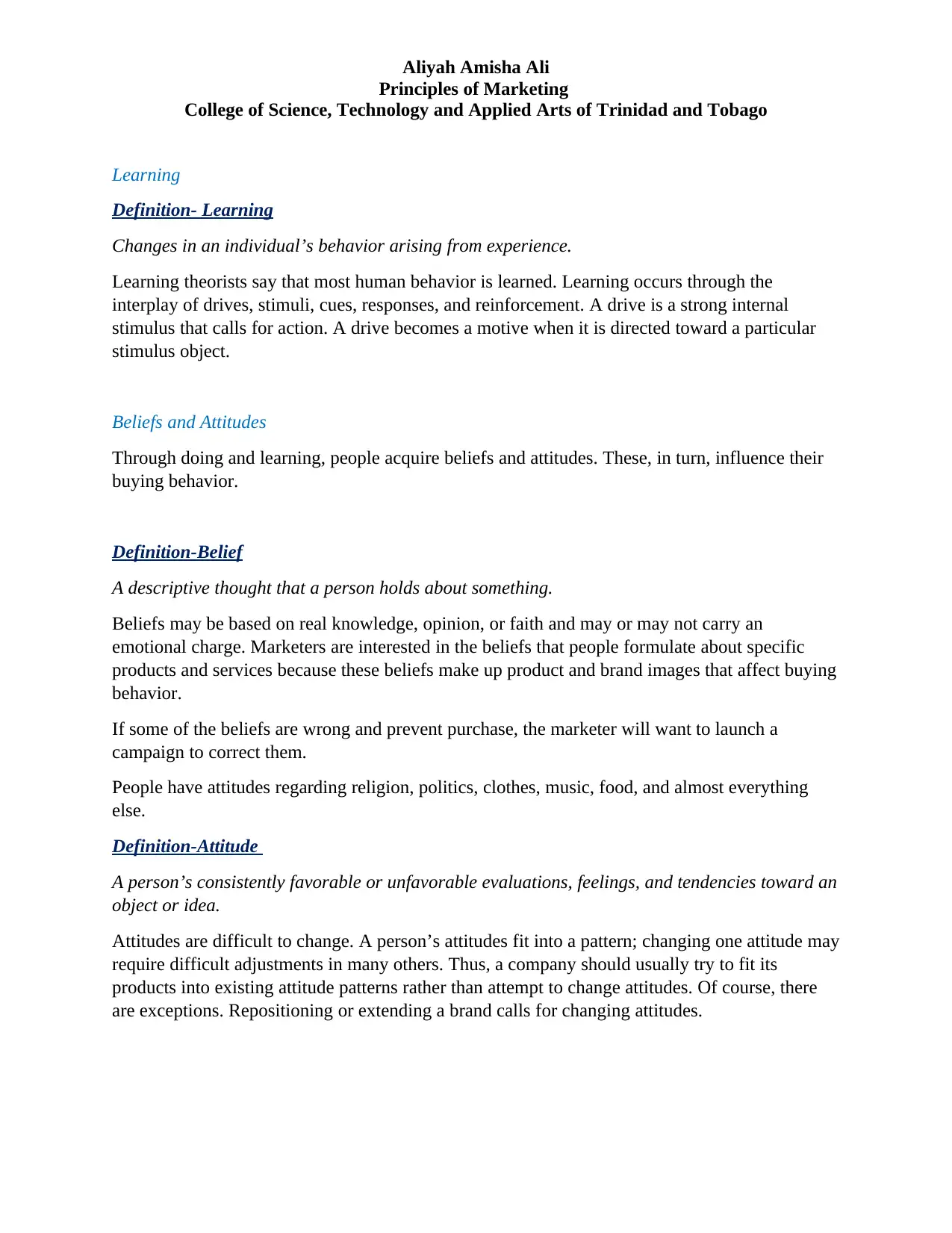
Aliyah Amisha Ali
Principles of Marketing
College of Science, Technology and Applied Arts of Trinidad and Tobago
Learning
Definition- Learning
Changes in an individual’s behavior arising from experience.
Learning theorists say that most human behavior is learned. Learning occurs through the
interplay of drives, stimuli, cues, responses, and reinforcement. A drive is a strong internal
stimulus that calls for action. A drive becomes a motive when it is directed toward a particular
stimulus object.
Beliefs and Attitudes
Through doing and learning, people acquire beliefs and attitudes. These, in turn, influence their
buying behavior.
Definition-Belief
A descriptive thought that a person holds about something.
Beliefs may be based on real knowledge, opinion, or faith and may or may not carry an
emotional charge. Marketers are interested in the beliefs that people formulate about specific
products and services because these beliefs make up product and brand images that affect buying
behavior.
If some of the beliefs are wrong and prevent purchase, the marketer will want to launch a
campaign to correct them.
People have attitudes regarding religion, politics, clothes, music, food, and almost everything
else.
Definition-Attitude
A person’s consistently favorable or unfavorable evaluations, feelings, and tendencies toward an
object or idea.
Attitudes are difficult to change. A person’s attitudes fit into a pattern; changing one attitude may
require difficult adjustments in many others. Thus, a company should usually try to fit its
products into existing attitude patterns rather than attempt to change attitudes. Of course, there
are exceptions. Repositioning or extending a brand calls for changing attitudes.
Principles of Marketing
College of Science, Technology and Applied Arts of Trinidad and Tobago
Learning
Definition- Learning
Changes in an individual’s behavior arising from experience.
Learning theorists say that most human behavior is learned. Learning occurs through the
interplay of drives, stimuli, cues, responses, and reinforcement. A drive is a strong internal
stimulus that calls for action. A drive becomes a motive when it is directed toward a particular
stimulus object.
Beliefs and Attitudes
Through doing and learning, people acquire beliefs and attitudes. These, in turn, influence their
buying behavior.
Definition-Belief
A descriptive thought that a person holds about something.
Beliefs may be based on real knowledge, opinion, or faith and may or may not carry an
emotional charge. Marketers are interested in the beliefs that people formulate about specific
products and services because these beliefs make up product and brand images that affect buying
behavior.
If some of the beliefs are wrong and prevent purchase, the marketer will want to launch a
campaign to correct them.
People have attitudes regarding religion, politics, clothes, music, food, and almost everything
else.
Definition-Attitude
A person’s consistently favorable or unfavorable evaluations, feelings, and tendencies toward an
object or idea.
Attitudes are difficult to change. A person’s attitudes fit into a pattern; changing one attitude may
require difficult adjustments in many others. Thus, a company should usually try to fit its
products into existing attitude patterns rather than attempt to change attitudes. Of course, there
are exceptions. Repositioning or extending a brand calls for changing attitudes.
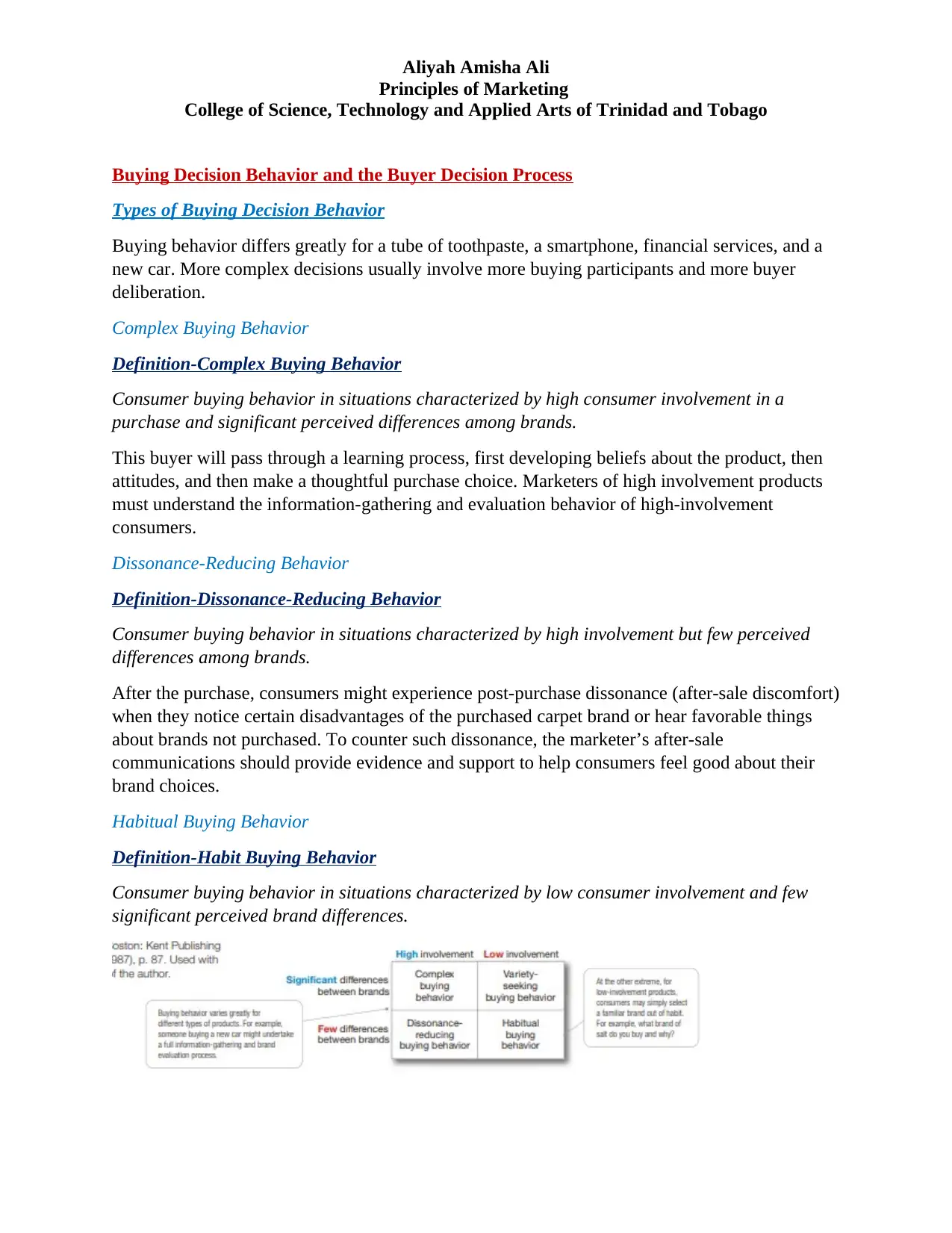
Aliyah Amisha Ali
Principles of Marketing
College of Science, Technology and Applied Arts of Trinidad and Tobago
Buying Decision Behavior and the Buyer Decision Process
Types of Buying Decision Behavior
Buying behavior differs greatly for a tube of toothpaste, a smartphone, financial services, and a
new car. More complex decisions usually involve more buying participants and more buyer
deliberation.
Complex Buying Behavior
Definition-Complex Buying Behavior
Consumer buying behavior in situations characterized by high consumer involvement in a
purchase and significant perceived differences among brands.
This buyer will pass through a learning process, first developing beliefs about the product, then
attitudes, and then make a thoughtful purchase choice. Marketers of high involvement products
must understand the information-gathering and evaluation behavior of high-involvement
consumers.
Dissonance-Reducing Behavior
Definition-Dissonance-Reducing Behavior
Consumer buying behavior in situations characterized by high involvement but few perceived
differences among brands.
After the purchase, consumers might experience post-purchase dissonance (after-sale discomfort)
when they notice certain disadvantages of the purchased carpet brand or hear favorable things
about brands not purchased. To counter such dissonance, the marketer’s after-sale
communications should provide evidence and support to help consumers feel good about their
brand choices.
Habitual Buying Behavior
Definition-Habit Buying Behavior
Consumer buying behavior in situations characterized by low consumer involvement and few
significant perceived brand differences.
Principles of Marketing
College of Science, Technology and Applied Arts of Trinidad and Tobago
Buying Decision Behavior and the Buyer Decision Process
Types of Buying Decision Behavior
Buying behavior differs greatly for a tube of toothpaste, a smartphone, financial services, and a
new car. More complex decisions usually involve more buying participants and more buyer
deliberation.
Complex Buying Behavior
Definition-Complex Buying Behavior
Consumer buying behavior in situations characterized by high consumer involvement in a
purchase and significant perceived differences among brands.
This buyer will pass through a learning process, first developing beliefs about the product, then
attitudes, and then make a thoughtful purchase choice. Marketers of high involvement products
must understand the information-gathering and evaluation behavior of high-involvement
consumers.
Dissonance-Reducing Behavior
Definition-Dissonance-Reducing Behavior
Consumer buying behavior in situations characterized by high involvement but few perceived
differences among brands.
After the purchase, consumers might experience post-purchase dissonance (after-sale discomfort)
when they notice certain disadvantages of the purchased carpet brand or hear favorable things
about brands not purchased. To counter such dissonance, the marketer’s after-sale
communications should provide evidence and support to help consumers feel good about their
brand choices.
Habitual Buying Behavior
Definition-Habit Buying Behavior
Consumer buying behavior in situations characterized by low consumer involvement and few
significant perceived brand differences.
Secure Best Marks with AI Grader
Need help grading? Try our AI Grader for instant feedback on your assignments.
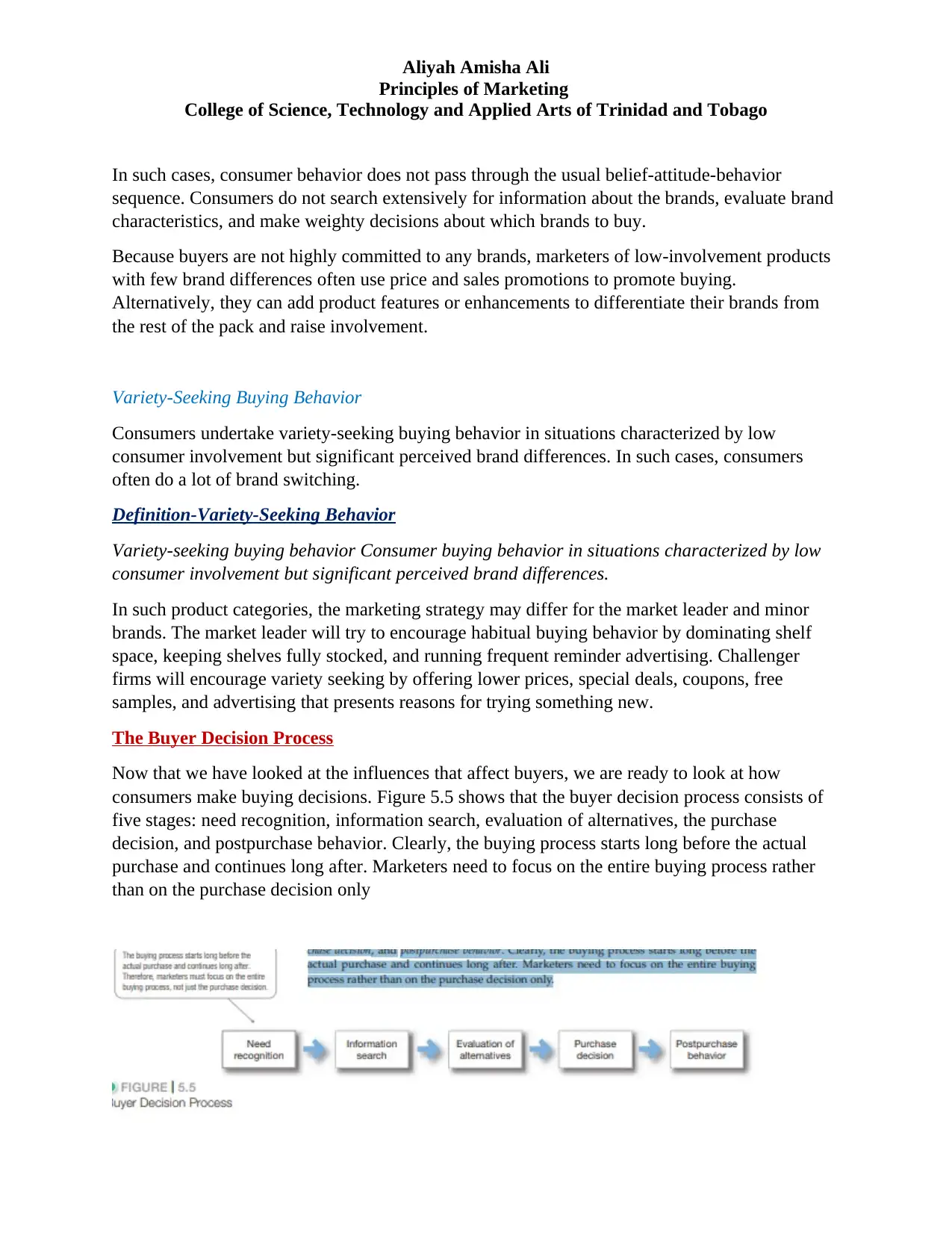
Aliyah Amisha Ali
Principles of Marketing
College of Science, Technology and Applied Arts of Trinidad and Tobago
In such cases, consumer behavior does not pass through the usual belief-attitude-behavior
sequence. Consumers do not search extensively for information about the brands, evaluate brand
characteristics, and make weighty decisions about which brands to buy.
Because buyers are not highly committed to any brands, marketers of low-involvement products
with few brand differences often use price and sales promotions to promote buying.
Alternatively, they can add product features or enhancements to differentiate their brands from
the rest of the pack and raise involvement.
Variety-Seeking Buying Behavior
Consumers undertake variety-seeking buying behavior in situations characterized by low
consumer involvement but significant perceived brand differences. In such cases, consumers
often do a lot of brand switching.
Definition-Variety-Seeking Behavior
Variety-seeking buying behavior Consumer buying behavior in situations characterized by low
consumer involvement but significant perceived brand differences.
In such product categories, the marketing strategy may differ for the market leader and minor
brands. The market leader will try to encourage habitual buying behavior by dominating shelf
space, keeping shelves fully stocked, and running frequent reminder advertising. Challenger
firms will encourage variety seeking by offering lower prices, special deals, coupons, free
samples, and advertising that presents reasons for trying something new.
The Buyer Decision Process
Now that we have looked at the influences that affect buyers, we are ready to look at how
consumers make buying decisions. Figure 5.5 shows that the buyer decision process consists of
five stages: need recognition, information search, evaluation of alternatives, the purchase
decision, and postpurchase behavior. Clearly, the buying process starts long before the actual
purchase and continues long after. Marketers need to focus on the entire buying process rather
than on the purchase decision only
Principles of Marketing
College of Science, Technology and Applied Arts of Trinidad and Tobago
In such cases, consumer behavior does not pass through the usual belief-attitude-behavior
sequence. Consumers do not search extensively for information about the brands, evaluate brand
characteristics, and make weighty decisions about which brands to buy.
Because buyers are not highly committed to any brands, marketers of low-involvement products
with few brand differences often use price and sales promotions to promote buying.
Alternatively, they can add product features or enhancements to differentiate their brands from
the rest of the pack and raise involvement.
Variety-Seeking Buying Behavior
Consumers undertake variety-seeking buying behavior in situations characterized by low
consumer involvement but significant perceived brand differences. In such cases, consumers
often do a lot of brand switching.
Definition-Variety-Seeking Behavior
Variety-seeking buying behavior Consumer buying behavior in situations characterized by low
consumer involvement but significant perceived brand differences.
In such product categories, the marketing strategy may differ for the market leader and minor
brands. The market leader will try to encourage habitual buying behavior by dominating shelf
space, keeping shelves fully stocked, and running frequent reminder advertising. Challenger
firms will encourage variety seeking by offering lower prices, special deals, coupons, free
samples, and advertising that presents reasons for trying something new.
The Buyer Decision Process
Now that we have looked at the influences that affect buyers, we are ready to look at how
consumers make buying decisions. Figure 5.5 shows that the buyer decision process consists of
five stages: need recognition, information search, evaluation of alternatives, the purchase
decision, and postpurchase behavior. Clearly, the buying process starts long before the actual
purchase and continues long after. Marketers need to focus on the entire buying process rather
than on the purchase decision only
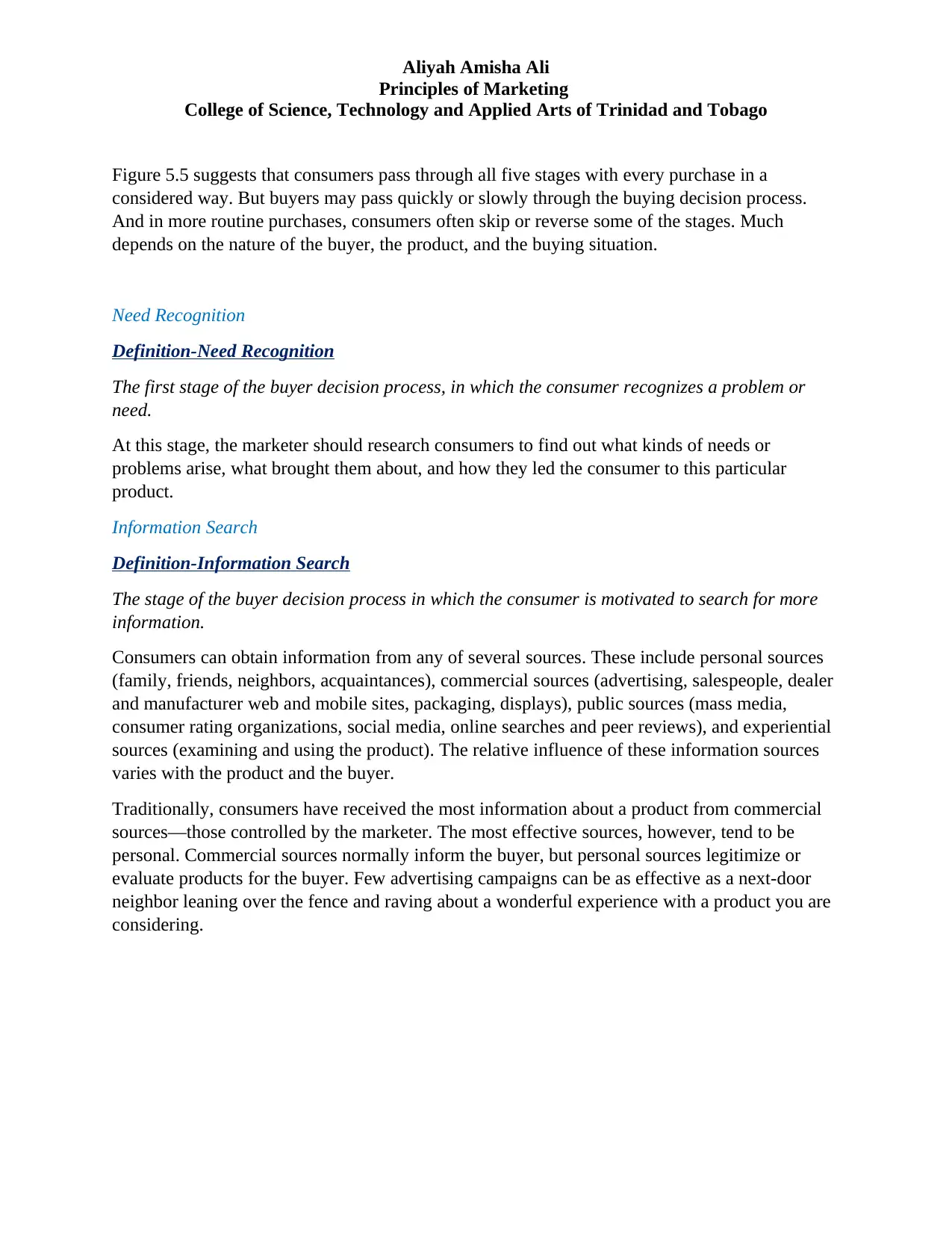
Aliyah Amisha Ali
Principles of Marketing
College of Science, Technology and Applied Arts of Trinidad and Tobago
Figure 5.5 suggests that consumers pass through all five stages with every purchase in a
considered way. But buyers may pass quickly or slowly through the buying decision process.
And in more routine purchases, consumers often skip or reverse some of the stages. Much
depends on the nature of the buyer, the product, and the buying situation.
Need Recognition
Definition-Need Recognition
The first stage of the buyer decision process, in which the consumer recognizes a problem or
need.
At this stage, the marketer should research consumers to find out what kinds of needs or
problems arise, what brought them about, and how they led the consumer to this particular
product.
Information Search
Definition-Information Search
The stage of the buyer decision process in which the consumer is motivated to search for more
information.
Consumers can obtain information from any of several sources. These include personal sources
(family, friends, neighbors, acquaintances), commercial sources (advertising, salespeople, dealer
and manufacturer web and mobile sites, packaging, displays), public sources (mass media,
consumer rating organizations, social media, online searches and peer reviews), and experiential
sources (examining and using the product). The relative influence of these information sources
varies with the product and the buyer.
Traditionally, consumers have received the most information about a product from commercial
sources—those controlled by the marketer. The most effective sources, however, tend to be
personal. Commercial sources normally inform the buyer, but personal sources legitimize or
evaluate products for the buyer. Few advertising campaigns can be as effective as a next-door
neighbor leaning over the fence and raving about a wonderful experience with a product you are
considering.
Principles of Marketing
College of Science, Technology and Applied Arts of Trinidad and Tobago
Figure 5.5 suggests that consumers pass through all five stages with every purchase in a
considered way. But buyers may pass quickly or slowly through the buying decision process.
And in more routine purchases, consumers often skip or reverse some of the stages. Much
depends on the nature of the buyer, the product, and the buying situation.
Need Recognition
Definition-Need Recognition
The first stage of the buyer decision process, in which the consumer recognizes a problem or
need.
At this stage, the marketer should research consumers to find out what kinds of needs or
problems arise, what brought them about, and how they led the consumer to this particular
product.
Information Search
Definition-Information Search
The stage of the buyer decision process in which the consumer is motivated to search for more
information.
Consumers can obtain information from any of several sources. These include personal sources
(family, friends, neighbors, acquaintances), commercial sources (advertising, salespeople, dealer
and manufacturer web and mobile sites, packaging, displays), public sources (mass media,
consumer rating organizations, social media, online searches and peer reviews), and experiential
sources (examining and using the product). The relative influence of these information sources
varies with the product and the buyer.
Traditionally, consumers have received the most information about a product from commercial
sources—those controlled by the marketer. The most effective sources, however, tend to be
personal. Commercial sources normally inform the buyer, but personal sources legitimize or
evaluate products for the buyer. Few advertising campaigns can be as effective as a next-door
neighbor leaning over the fence and raving about a wonderful experience with a product you are
considering.
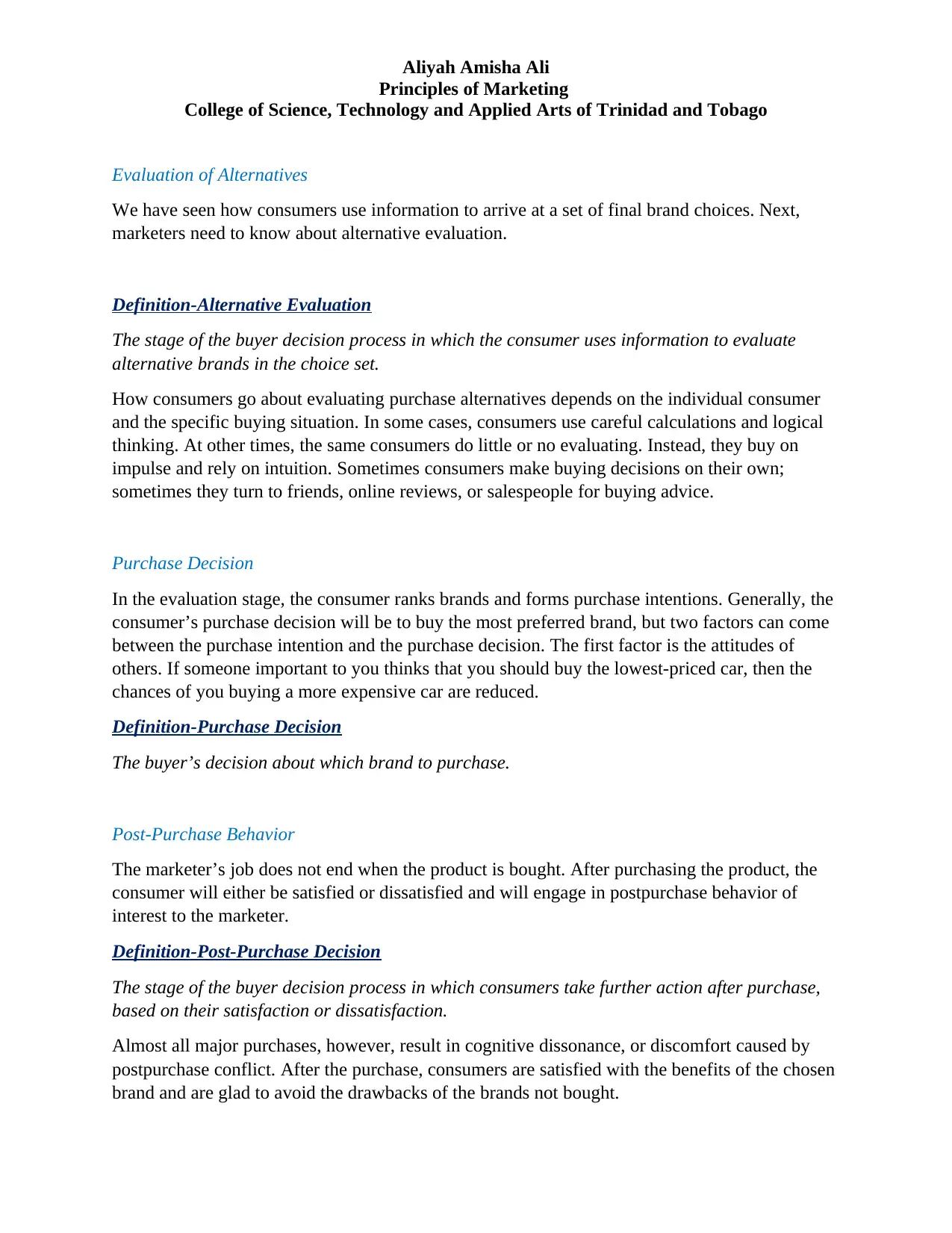
Aliyah Amisha Ali
Principles of Marketing
College of Science, Technology and Applied Arts of Trinidad and Tobago
Evaluation of Alternatives
We have seen how consumers use information to arrive at a set of final brand choices. Next,
marketers need to know about alternative evaluation.
Definition-Alternative Evaluation
The stage of the buyer decision process in which the consumer uses information to evaluate
alternative brands in the choice set.
How consumers go about evaluating purchase alternatives depends on the individual consumer
and the specific buying situation. In some cases, consumers use careful calculations and logical
thinking. At other times, the same consumers do little or no evaluating. Instead, they buy on
impulse and rely on intuition. Sometimes consumers make buying decisions on their own;
sometimes they turn to friends, online reviews, or salespeople for buying advice.
Purchase Decision
In the evaluation stage, the consumer ranks brands and forms purchase intentions. Generally, the
consumer’s purchase decision will be to buy the most preferred brand, but two factors can come
between the purchase intention and the purchase decision. The first factor is the attitudes of
others. If someone important to you thinks that you should buy the lowest-priced car, then the
chances of you buying a more expensive car are reduced.
Definition-Purchase Decision
The buyer’s decision about which brand to purchase.
Post-Purchase Behavior
The marketer’s job does not end when the product is bought. After purchasing the product, the
consumer will either be satisfied or dissatisfied and will engage in postpurchase behavior of
interest to the marketer.
Definition-Post-Purchase Decision
The stage of the buyer decision process in which consumers take further action after purchase,
based on their satisfaction or dissatisfaction.
Almost all major purchases, however, result in cognitive dissonance, or discomfort caused by
postpurchase conflict. After the purchase, consumers are satisfied with the benefits of the chosen
brand and are glad to avoid the drawbacks of the brands not bought.
Principles of Marketing
College of Science, Technology and Applied Arts of Trinidad and Tobago
Evaluation of Alternatives
We have seen how consumers use information to arrive at a set of final brand choices. Next,
marketers need to know about alternative evaluation.
Definition-Alternative Evaluation
The stage of the buyer decision process in which the consumer uses information to evaluate
alternative brands in the choice set.
How consumers go about evaluating purchase alternatives depends on the individual consumer
and the specific buying situation. In some cases, consumers use careful calculations and logical
thinking. At other times, the same consumers do little or no evaluating. Instead, they buy on
impulse and rely on intuition. Sometimes consumers make buying decisions on their own;
sometimes they turn to friends, online reviews, or salespeople for buying advice.
Purchase Decision
In the evaluation stage, the consumer ranks brands and forms purchase intentions. Generally, the
consumer’s purchase decision will be to buy the most preferred brand, but two factors can come
between the purchase intention and the purchase decision. The first factor is the attitudes of
others. If someone important to you thinks that you should buy the lowest-priced car, then the
chances of you buying a more expensive car are reduced.
Definition-Purchase Decision
The buyer’s decision about which brand to purchase.
Post-Purchase Behavior
The marketer’s job does not end when the product is bought. After purchasing the product, the
consumer will either be satisfied or dissatisfied and will engage in postpurchase behavior of
interest to the marketer.
Definition-Post-Purchase Decision
The stage of the buyer decision process in which consumers take further action after purchase,
based on their satisfaction or dissatisfaction.
Almost all major purchases, however, result in cognitive dissonance, or discomfort caused by
postpurchase conflict. After the purchase, consumers are satisfied with the benefits of the chosen
brand and are glad to avoid the drawbacks of the brands not bought.
Paraphrase This Document
Need a fresh take? Get an instant paraphrase of this document with our AI Paraphraser
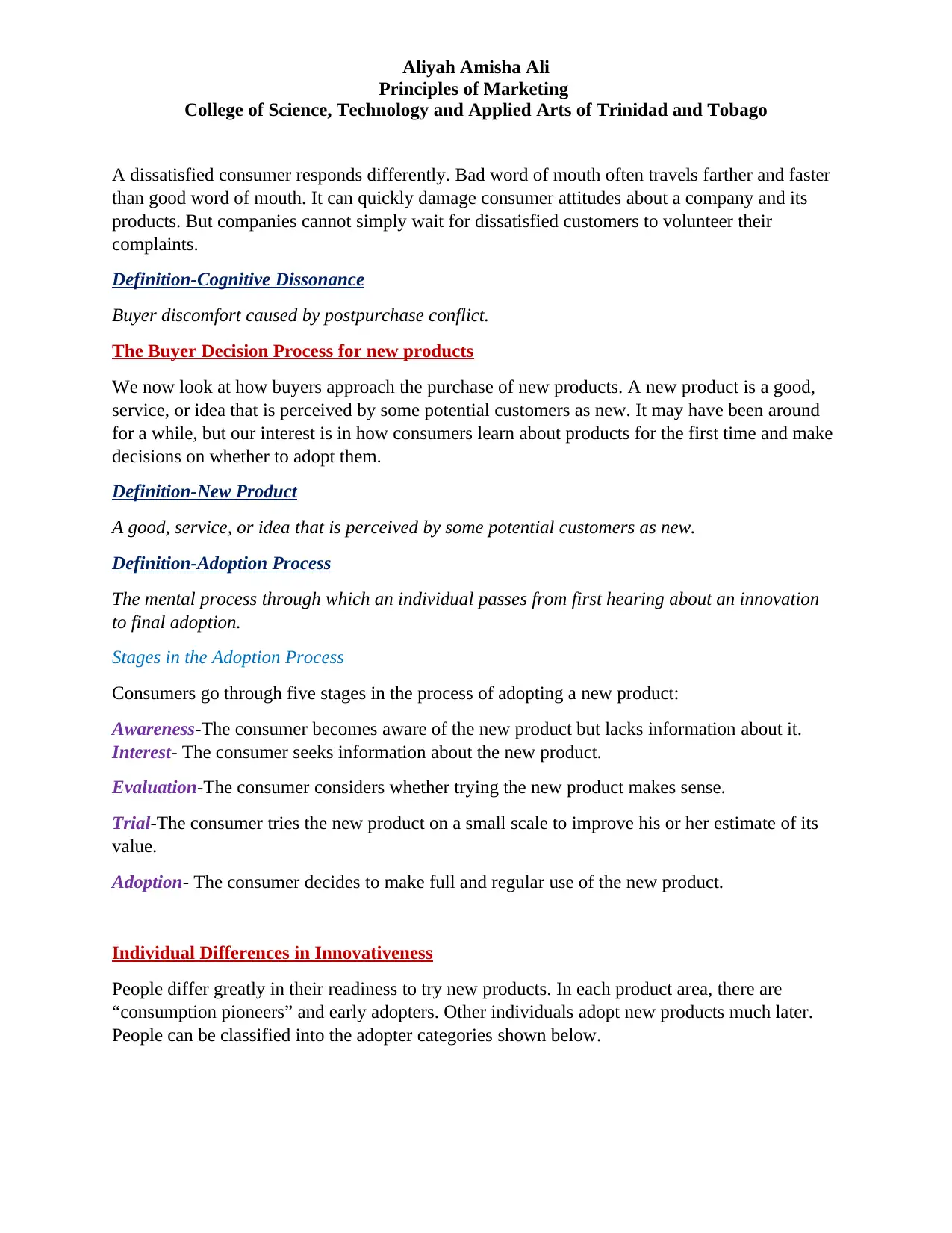
Aliyah Amisha Ali
Principles of Marketing
College of Science, Technology and Applied Arts of Trinidad and Tobago
A dissatisfied consumer responds differently. Bad word of mouth often travels farther and faster
than good word of mouth. It can quickly damage consumer attitudes about a company and its
products. But companies cannot simply wait for dissatisfied customers to volunteer their
complaints.
Definition-Cognitive Dissonance
Buyer discomfort caused by postpurchase conflict.
The Buyer Decision Process for new products
We now look at how buyers approach the purchase of new products. A new product is a good,
service, or idea that is perceived by some potential customers as new. It may have been around
for a while, but our interest is in how consumers learn about products for the first time and make
decisions on whether to adopt them.
Definition-New Product
A good, service, or idea that is perceived by some potential customers as new.
Definition-Adoption Process
The mental process through which an individual passes from first hearing about an innovation
to final adoption.
Stages in the Adoption Process
Consumers go through five stages in the process of adopting a new product:
Awareness-The consumer becomes aware of the new product but lacks information about it.
Interest- The consumer seeks information about the new product.
Evaluation-The consumer considers whether trying the new product makes sense.
Trial-The consumer tries the new product on a small scale to improve his or her estimate of its
value.
Adoption- The consumer decides to make full and regular use of the new product.
Individual Differences in Innovativeness
People differ greatly in their readiness to try new products. In each product area, there are
“consumption pioneers” and early adopters. Other individuals adopt new products much later.
People can be classified into the adopter categories shown below.
Principles of Marketing
College of Science, Technology and Applied Arts of Trinidad and Tobago
A dissatisfied consumer responds differently. Bad word of mouth often travels farther and faster
than good word of mouth. It can quickly damage consumer attitudes about a company and its
products. But companies cannot simply wait for dissatisfied customers to volunteer their
complaints.
Definition-Cognitive Dissonance
Buyer discomfort caused by postpurchase conflict.
The Buyer Decision Process for new products
We now look at how buyers approach the purchase of new products. A new product is a good,
service, or idea that is perceived by some potential customers as new. It may have been around
for a while, but our interest is in how consumers learn about products for the first time and make
decisions on whether to adopt them.
Definition-New Product
A good, service, or idea that is perceived by some potential customers as new.
Definition-Adoption Process
The mental process through which an individual passes from first hearing about an innovation
to final adoption.
Stages in the Adoption Process
Consumers go through five stages in the process of adopting a new product:
Awareness-The consumer becomes aware of the new product but lacks information about it.
Interest- The consumer seeks information about the new product.
Evaluation-The consumer considers whether trying the new product makes sense.
Trial-The consumer tries the new product on a small scale to improve his or her estimate of its
value.
Adoption- The consumer decides to make full and regular use of the new product.
Individual Differences in Innovativeness
People differ greatly in their readiness to try new products. In each product area, there are
“consumption pioneers” and early adopters. Other individuals adopt new products much later.
People can be classified into the adopter categories shown below.
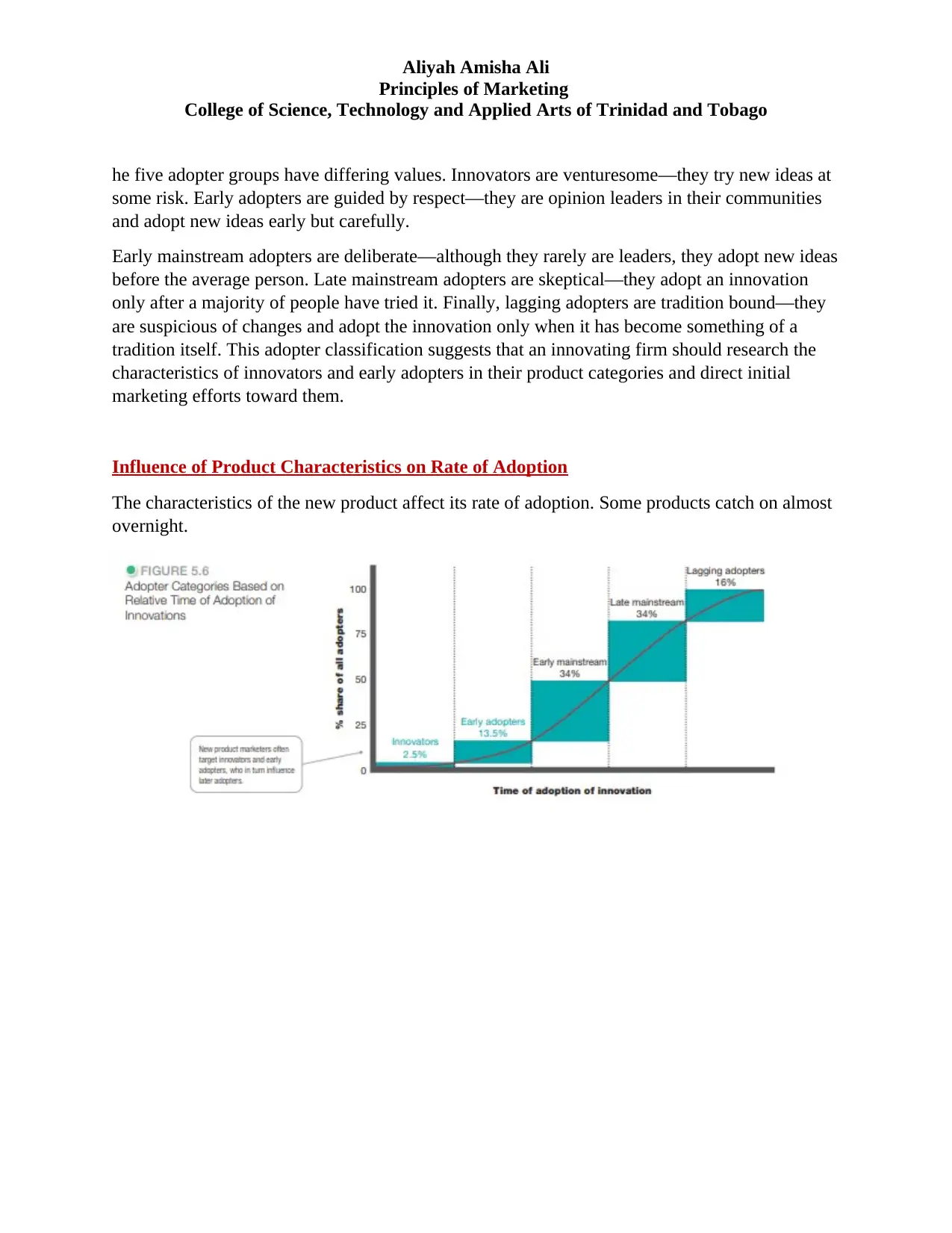
Aliyah Amisha Ali
Principles of Marketing
College of Science, Technology and Applied Arts of Trinidad and Tobago
he five adopter groups have differing values. Innovators are venturesome—they try new ideas at
some risk. Early adopters are guided by respect—they are opinion leaders in their communities
and adopt new ideas early but carefully.
Early mainstream adopters are deliberate—although they rarely are leaders, they adopt new ideas
before the average person. Late mainstream adopters are skeptical—they adopt an innovation
only after a majority of people have tried it. Finally, lagging adopters are tradition bound—they
are suspicious of changes and adopt the innovation only when it has become something of a
tradition itself. This adopter classification suggests that an innovating firm should research the
characteristics of innovators and early adopters in their product categories and direct initial
marketing efforts toward them.
Influence of Product Characteristics on Rate of Adoption
The characteristics of the new product affect its rate of adoption. Some products catch on almost
overnight.
Principles of Marketing
College of Science, Technology and Applied Arts of Trinidad and Tobago
he five adopter groups have differing values. Innovators are venturesome—they try new ideas at
some risk. Early adopters are guided by respect—they are opinion leaders in their communities
and adopt new ideas early but carefully.
Early mainstream adopters are deliberate—although they rarely are leaders, they adopt new ideas
before the average person. Late mainstream adopters are skeptical—they adopt an innovation
only after a majority of people have tried it. Finally, lagging adopters are tradition bound—they
are suspicious of changes and adopt the innovation only when it has become something of a
tradition itself. This adopter classification suggests that an innovating firm should research the
characteristics of innovators and early adopters in their product categories and direct initial
marketing efforts toward them.
Influence of Product Characteristics on Rate of Adoption
The characteristics of the new product affect its rate of adoption. Some products catch on almost
overnight.
1 out of 15
Related Documents
Your All-in-One AI-Powered Toolkit for Academic Success.
+13062052269
info@desklib.com
Available 24*7 on WhatsApp / Email
![[object Object]](/_next/static/media/star-bottom.7253800d.svg)
Unlock your academic potential
© 2024 | Zucol Services PVT LTD | All rights reserved.




